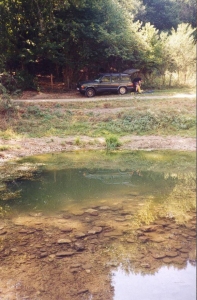| After leaving the Cote d'Or we moved on to the Comté region and the Jura mountains. The journey only takes a couple of hours but we broke it up by stopping in Besancon. The Comté has always been fiercly independant and has gone through periods of self-rule and oppression by French royalty. Besancon was the site of Comté's last stand and the striking Citadel, perched on a limestone rock which towers over the city, was built by Verdun to ensure that Comté would never again rise against the crown. The Citadel today is like a mad king's palace, monkeys and goats scurry through the ramparts and dried up moats, lions and tigers bask in the sun in a courtyard and a tower has been turned into an aquarium. Besancon itself is a lively city, full of bars and restaurants, well worth a stop. | Introduction
Cote d'Or Jura Switzerland Order Book |
 Continuing
through the mountains and over the Pontarlier plateau and down past the
Lac du Joux we stopped in Malbuisson. Malbuisson in winter is a resort
for cross country skiers but in summer it is busy beach town. Just to the
north is a small gorge, heavy with the scent of pine. At its head is a
bright blue pool known as the Source Bleue. According to legend when the
local Count returned from the Crusades he found his wife had taken a lover.
He was hanged from a tree in the forest and the Countess was imprisoned
in a tower where, so the story goes, her tears filled the pool of Source
Bleue. Continuing
through the mountains and over the Pontarlier plateau and down past the
Lac du Joux we stopped in Malbuisson. Malbuisson in winter is a resort
for cross country skiers but in summer it is busy beach town. Just to the
north is a small gorge, heavy with the scent of pine. At its head is a
bright blue pool known as the Source Bleue. According to legend when the
local Count returned from the Crusades he found his wife had taken a lover.
He was hanged from a tree in the forest and the Countess was imprisoned
in a tower where, so the story goes, her tears filled the pool of Source
Bleue. |
|
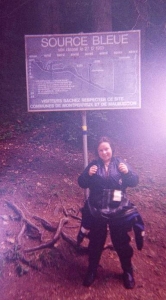 The
pool leads to a low arch and squeezing through this gives way to a large,
white walled passage that twists through the mountainside. Another squeeze
opens in to a rift that goes up into a chamber with a waterfall. The
pool leads to a low arch and squeezing through this gives way to a large,
white walled passage that twists through the mountainside. Another squeeze
opens in to a rift that goes up into a chamber with a waterfall. |
|
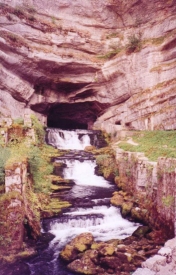 The
region is famous for a geological feature known as a reculee. These
are deep, blind canyons carved from the limestone plateau by rivers which
resurge at the head of the canyon. The river Loue rises in one of these
reculees
and was made famous by the painter and revolutionary Gustave Courbet. A
great waterfall pours from a black hole at the foot of a cliff. The father
of speleology, EA Martel, discovered that if he poured fluorosceine dye
into a fissure in the bed of the River Doubs then a couple of days later
it would appear here, proving the existence of underground rivers. Martel
was inspired by a fire at the nearby Pernod factory when the foremen dumped
a million litres of Pernod into the river. The local springs then turned
white and smelled of aniseed! The
region is famous for a geological feature known as a reculee. These
are deep, blind canyons carved from the limestone plateau by rivers which
resurge at the head of the canyon. The river Loue rises in one of these
reculees
and was made famous by the painter and revolutionary Gustave Courbet. A
great waterfall pours from a black hole at the foot of a cliff. The father
of speleology, EA Martel, discovered that if he poured fluorosceine dye
into a fissure in the bed of the River Doubs then a couple of days later
it would appear here, proving the existence of underground rivers. Martel
was inspired by a fire at the nearby Pernod factory when the foremen dumped
a million litres of Pernod into the river. The local springs then turned
white and smelled of aniseed! |
|
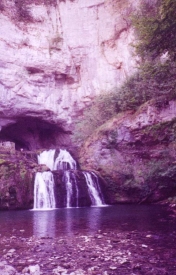 Martel's
discovery had a huge impact on the region. Factory owners in Pontarlier
who used the river Doubs for power often experienced problems in summer
when the river was dry. They believed that the water was escaping through
Martel's fissures and began grouting them up with cement. The result was
that the Lison spring dried up to the outcry of the local people. The anger
was so great that not only were the factory owners stopped but the region's
hydrology and ecology were protected by what is possibly the first introduction
of environmental protection legislation. Martel's
discovery had a huge impact on the region. Factory owners in Pontarlier
who used the river Doubs for power often experienced problems in summer
when the river was dry. They believed that the water was escaping through
Martel's fissures and began grouting them up with cement. The result was
that the Lison spring dried up to the outcry of the local people. The anger
was so great that not only were the factory owners stopped but the region's
hydrology and ecology were protected by what is possibly the first introduction
of environmental protection legislation.
The Lison spring
is possibly the site of the first cave diving death. A little girl fell
into the nearby Creux Billard, a pot hole where a river sinks, and drowned.
Her body was never found until months later she was washed out of the Lison.
The Lison is an extensive underwater system and makes for an excellent
dive however conditions can be variable. The water was extremely clear
on our visit and is one of the most impressive French sites I have visited.
To give an idea of scale, the small white specks at the top of the waterfall
are people.
|
|
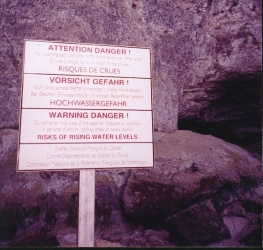 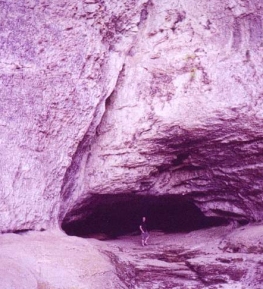 Another
part of the park is the Grotte Sarrazine. This is a dry cave which
leads to series of sumps that lad back into the Lison system. Outside
the air temperature was well over 30degC but inside the cave was a chilly
8-10degC. In wet weather the whole system floods quickly and the gorge
outside has a tidemark a good 4-5m above ground level. Another
part of the park is the Grotte Sarrazine. This is a dry cave which
leads to series of sumps that lad back into the Lison system. Outside
the air temperature was well over 30degC but inside the cave was a chilly
8-10degC. In wet weather the whole system floods quickly and the gorge
outside has a tidemark a good 4-5m above ground level. |
|
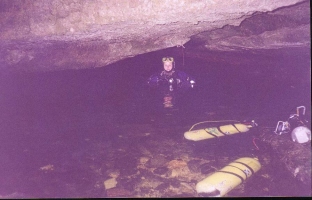 The
Source de la Dessoubre is in a wide canyon known as the Cirque de Consolation.
The
spring is at the foot of a cliff and was once the water supply for a nearby
convent. It is around 1500m long, generally very shallow and considerably
warmer than many of the other sites. There is a series of four sumps, the
first three being wide but low and often narrow and the fourth starts at
the end of a massive canal and is very large. The visibility is rarely
more than 4m and the whole site is very similar to what you would expect
to find in a Yorkshire resurgence cave. The
Source de la Dessoubre is in a wide canyon known as the Cirque de Consolation.
The
spring is at the foot of a cliff and was once the water supply for a nearby
convent. It is around 1500m long, generally very shallow and considerably
warmer than many of the other sites. There is a series of four sumps, the
first three being wide but low and often narrow and the fourth starts at
the end of a massive canal and is very large. The visibility is rarely
more than 4m and the whole site is very similar to what you would expect
to find in a Yorkshire resurgence cave. |
|
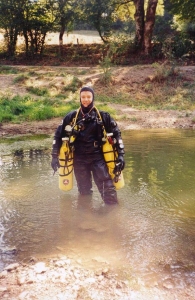 We
found the Source du Gour by accident. I drove to the village of Bouclans
in search of the Source Bleue du Cusance and it wasn't until I read the
entry in my own guide book that I realised why we could not find it. Wrong
cave. We
found the Source du Gour by accident. I drove to the village of Bouclans
in search of the Source Bleue du Cusance and it wasn't until I read the
entry in my own guide book that I realised why we could not find it. Wrong
cave.
The Source du
Gour is a cave system which consists of three legs which go in different
directions for many kilometres. To get into the system a short sump of
200m has to be passed. The entrance is a pool behind some buildings and
in low water is stagnant and brown. The cave mouth is a narrow slot at
the foot of a slope of debris and gravel held back by a rusted steel pole.
Any movement makes the rubble start to move worryingly towards the cave
entrance. |
|
| Our final stop in the Jura region was the Source Bleue du Cusance. We finally found it, it wasn't that hard, it was in the village of Cusance and was marked "Source Bleue". The Source is a quiet pond amongst the forest. The ground is red and deep with leaves and the pool is bright blue and full of blackened fallen tree trunks. A narrow slot leads into a long rift passage, perhaps 10-15m high in some places but less than a metre wide. The walls are ragged and sharp and everything is covered in silt. Any movement, even breathing, turns the clear water to a murky brown and the exit will be in close to zero visibility, despite the excellent conditions on the way in. A great dive to finish on. |
